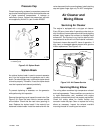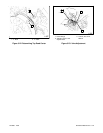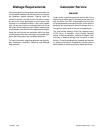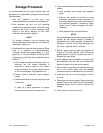
TP-5695 12/933-18 Scheduled Maintenance
Battery
The starting battery should be a 12-volt unit with a
minimum 250 CCA (cold cranking Amps) at 0_ F (--18_
C). When using a maintenance-free battery it is not
necessary to check the specific gravity or electrolyte
level. Otherwise, these procedures should be done at
the intervals specified in the Service Schedule.
WARNING
Sulfuric acid in batteries.
Can cause severe injury or death.
Use protective goggles and clothes. Can cause
permanent damage to eyes, burn skin, and eat holes
in clothing.
Sulfuric acid in batteries can cause severe injury or
death. Sulfuric acid in battery can cause permanent
damage to eyes, burn skin, and eat holes in clothing.
Always wear splash-proof safety goggles when working
around the battery. If battery electrolyte is splashed in
the eyes or on skin, immediately flush the affected area
for 15 minutes with large quantities of clean water. In the
case of eye contact, seek immediate medical aid. Never
add acid to a battery once the battery has been placed in
service. Doing so may result in hazardous spattering of
electrolyte.
Explosion can cause severe injury or death. Battery
gases can cause an explosion. Do not smoke or permit
flame or spark to occur near a battery at any time,
particularly when it is being charged. Avoid contacting
terminals with tools, etc. to prevent burns and to prevent
sparks that could cause an explosion. Remove
wristwatch, rings, and any other jewelry before handling
battery. Never connect negative (--) battery cable to
positive (+) connection terminal of starter solenoid. Do
not test battery condition by shorting terminals together
or sparks could ignite battery gases or fuel vapors. Any
compartment containing batteries must be well
ventilated to prevent accumulation of explosive gases.
To avoid sparks, do not disturb battery charger
connections while battery is being charged and always
turn charger off before disconnecting battery
connections. When disconnecting battery, remove
negative lead first and reconnect it last.
Cleaning
Keep battery clean by wiping it with a damp cloth. Keep
all electrical connections dry and tight. If corrosion is
present, disconnect cables from battery and remove
corrosion with a wire brush. Clean battery and cables
with a solution of baking soda and water. Be careful that
cleaning solution does not enter battery cells. When
cleaning is complete, flush battery and cables with clean
water and wipe with a dry cloth. After the battery cables
are reconnected, coat terminals with petroleum jelly,
silicon grease, or other nonconductive grease.
Checking Electrolyte Level
Check the level of electrolyte before each startup.
Remove filler caps and check to see that electrolyte
level is up to bottoms of filler holes, see Figure 3-20.
Refill as necessary with distilled water or clean tap
water. DO NOT add fresh electrolyte! Then reinstall and
tighten filler caps. If water is added during freezing
temperatures, run generator set 20--30 minutes to allow
mixing of added water and electrolyte. This will prevent
damage to battery due to freezing.
1
2
1. Filter Caps 2. Electrolyte Level
1-046
Figure 3-20. Checking Electrolyte Level
Checking Specific Gravity
Use a battery hydrometer to check the specific gravity of
the electrolyte in each battery cell. Correct actual
hydrometer readings for temperature. If the hydrometer
used does not have a correction table, use the one in
Figure 3-21. The battery is fully charged if the specific
gravity is 1.260 at an electrolyte temperature of 80_ F
(26.7_ C). The difference between specific gravities of


















